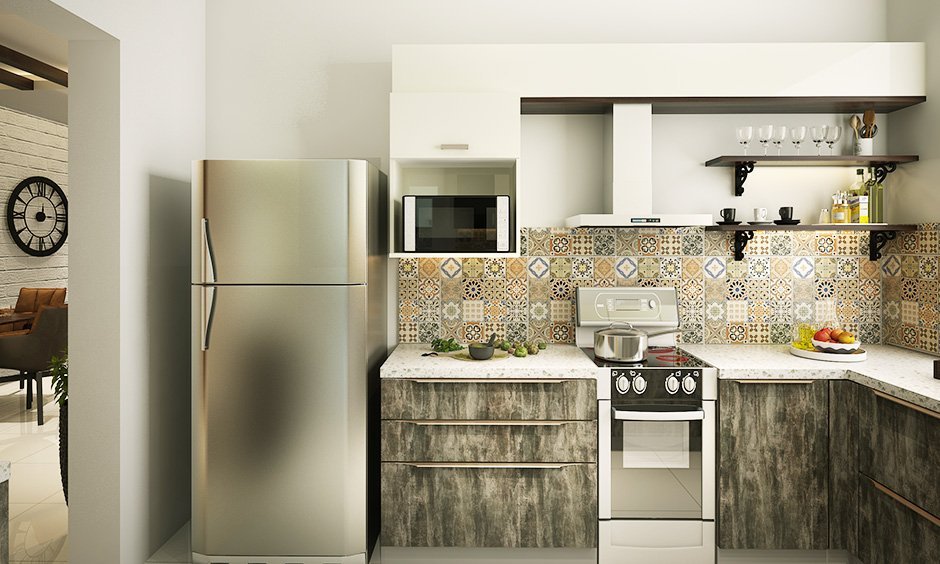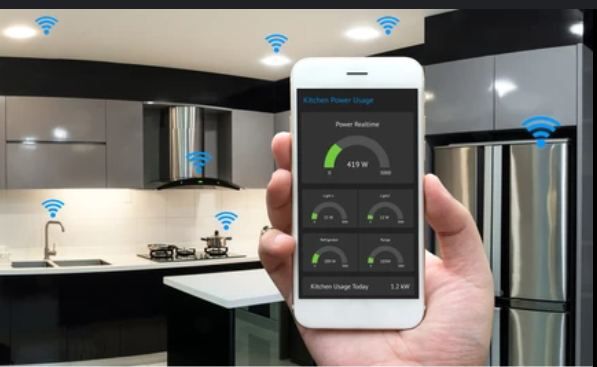Smart Kitchen Technology Trends 2025

The kitchen has long been the heart of the home, where culinary creativity meets daily routine. With the rapid advancement of smart technology, the kitchen is transforming into a hub of innovation and efficiency.
In 2024, smart kitchen technology is poised to revolutionize the way we cook, eat, and interact with our living spaces. Staying updated with the latest trends can help you create a kitchen that is not only modern but also highly functional and sustainable.
Smart Kitchen Technology Trends in 2024
This article delves into the top smart kitchen technology trends of 2024, offering insights into the future of culinary convenience and efficiency.
1. Integration of Artificial Intelligence (AI)

AI-Powered Kitchen Appliances
Artificial Intelligence (AI) is making significant inroads into the kitchen, offering unprecedented levels of convenience and precision. AI-powered ovens and refrigerators are leading the charge.
These appliances can recognize food items and suggest optimal cooking times and temperatures. For instance, an AI oven can automatically adjust its settings based on the type of food being cooked, ensuring perfect results every time.
Similarly, AI refrigerators can monitor food inventory, suggest recipes, and even notify you when items are about to expire.
AI-Driven Meal Planning and Nutrition
Beyond appliances, AI is also enhancing meal planning and nutrition. Smart meal planning apps leverage AI to provide personalized meal suggestions based on dietary preferences, nutritional needs, and available ingredients.
These apps can sync with smart refrigerators to track food inventory and generate shopping lists. By integrating with fitness and health apps, AI-driven meal planners can tailor recommendations to help users achieve their health and fitness goals.
2. Enhanced Connectivity and Interoperability
Let’s Review some points Related to Enhanced Connectivity and Interoperability.
Seamless Integration with Smart Home Ecosystems
One of the most significant trends in 2024 is the enhanced connectivity and interoperability of smart kitchen devices.
Appliances are now designed to integrate seamlessly with broader smart home ecosystems such as Amazon Alexa, Google Home, and Apple HomeKit. This unified control system allows users to manage all their smart devices from a single platform, enhancing convenience and user experience.
Inter-Device Communication
Inter-device communication is another critical aspect of this trend. Smart kitchen appliances are now capable of communicating with each other to optimize performance.
For example, a smart refrigerator can notify the oven to preheat when you take out ingredients for a recipe. This level of coordination streamlines the cooking process and ensures that everything is ready when you need it.
3. Advanced Voice and Gesture Control
Let’s Review the Advanced Voice and Gesture Control.
Improvements in Voice Control Technology
Voice control technology has become more sophisticated and user-friendly in 2024. Enhanced natural language processing capabilities make voice assistants more responsive and accurate.
Users can now give complex commands, such as setting multiple timers or adjusting cooking settings, with ease. Voice control is particularly beneficial in the kitchen, where hands-free operation can make cooking safer and more efficient.
Introduction of Gesture Control
Gesture control is an emerging trend that adds another layer of convenience to smart kitchen technology. Motion-sensing faucets and gesture-controlled ovens allow users to operate these devices without physical contact.
This feature is especially useful when your hands are dirty or full. For example, a simple wave of the hand can turn on the faucet or adjust the oven temperature, enhancing both hygiene and ease of use.
4. Sustainable and Energy-Efficient Solutions
Let’s Explore Sustainable and Energy-Efficient Solutions.
Energy-Efficient Smart Appliances
Sustainability is a key focus in the design of smart kitchen appliances in 2025. Energy-efficient models are becoming more prevalent, with features such as energy-saving modes, intelligent power management, and optimized performance.
For instance, smart dishwashers can run during off-peak hours to reduce energy consumption, while smart refrigerators adjust their cooling cycles based on usage patterns. These energy-saving features help reduce utility bills and minimize environmental impact.
Sustainable Materials and Eco-Friendly Designs
In addition to energy efficiency, there is a growing emphasis on using sustainable materials and eco-friendly designs in smart kitchen appliances.
Manufacturers are incorporating recycled materials into their products and designing appliances to be more durable and repairable. This focus on sustainability extends to the entire kitchen environment, with eco-friendly countertops, cabinetry, and flooring becoming more popular.
5. Smart Kitchen Robots and Automation
Let’s Review Smart Kitchen Robots and Automation.
Rise of Kitchen Robots
The rise of kitchen robots is one of the most exciting trends in smart kitchen technology. These robotic assistants are capable of performing a variety of tasks, from cooking and chopping to mixing and cleaning.
Robotic chefs, for instance, can prepare meals with precision and consistency, following pre-programmed recipes to the letter. These robots are equipped with advanced sensors and AI to adapt to different cooking styles and preferences.
Automation in Meal Preparation
Automation is also transforming meal preparation processes. Smart appliances can now automate cooking steps, from preheating the oven to stirring sauces. This level of automation not only saves time but also ensures that meals are prepared consistently every time.
Users can enjoy the convenience of having meals ready with minimal manual intervention, making it easier to enjoy home-cooked food even on busy days.
6. Enhanced Food Safety and Preservation
Let’s Review Enhanced Food Safety and Preservation.
Smart Food Storage Solutions
Food safety and preservation are critical considerations in the kitchen. Smart food storage solutions are addressing these concerns with innovative technologies.
For example, vacuum-sealing drawers and smart storage containers can extend the shelf life of food by maintaining optimal conditions. These solutions help reduce food waste and ensure that ingredients stay fresh for longer periods.
Advanced Monitoring for Food Safety
Advanced monitoring technologies are also enhancing food safety. Smart refrigerators and pantries are equipped with sensors that detect spoilage and contamination.
These sensors can alert users to potential issues, allowing for timely action to prevent foodborne illnesses. Additionally, some smart appliances can monitor and maintain specific humidity and temperature levels, ensuring that food is stored in the best possible conditions.
7. Personalized Cooking Experiences
Lets Explore the Trend Personalized Cooking Experiences.
Customizable Cooking Profiles
Personalization is a significant trend in smart kitchen technology for 2024. Customizable cooking profiles allow users to set preferences for individual family members. These profiles can include specific cooking times, temperatures, and methods based on personal tastes and dietary requirements.
For example, a smart oven can remember that one person prefers their steak medium-rare, while another likes it well-done.
Integration with Health and Fitness Apps
Smart kitchen devices are increasingly integrating with health and fitness apps to offer personalized cooking experiences. By syncing with fitness trackers and health apps, smart appliances can tailor meal suggestions to help users achieve their health goals.
For example, if your fitness app indicates that you need more protein, your smart refrigerator can suggest high-protein recipes and highlight relevant ingredients.
8. Innovations in Smart Kitchen Displays
Let’s Explore some of the Innovations in Smart Kitchen Displays.
Smart Touchscreens and Interactive Displays
Innovations in smart kitchen displays are enhancing the way users interact with their appliances. Smart touchscreens and interactive displays are becoming more common in kitchens, offering a range of functionalities.
These displays can be used for browsing recipes, watching cooking tutorials, and receiving step-by-step cooking guidance. Some smart displays are integrated with smart home hubs, allowing users to control other connected devices from the kitchen.
Augmented Reality (AR) in the Kitchen
Also Read: Smart Home Lighting Solutions (Beginners Guide)
Augmented Reality (AR) is another exciting development in smart kitchen technology. AR applications can provide interactive cooking instructions, overlaying digital information onto real-world objects.
For example, AR can guide users through complex recipes by displaying virtual ingredients and cooking steps directly on the kitchen counter. This technology makes cooking more intuitive and accessible, even for novice cooks.Also
9. Trends in Smart Kitchen Security
Let’s Explore Trends in Smart Kitchen Security.
Enhanced Security Features for Smart Appliances
As smart kitchen technology becomes more advanced, security concerns are also being addressed. Enhanced security features for smart appliances include encryption and secure connections to protect against hacking and unauthorized access.
User authentication and access control mechanisms ensure that only authorized users can operate the devices. These measures are essential to safeguard both the appliances and the personal data they collect.
Privacy Considerations
Privacy is a critical aspect of smart kitchen security. Users need to be aware of the data their smart devices collect and how it is used. Manufacturers are increasingly transparent about their data collection practices, and users are given more control over their data.
Understanding and managing data privacy is crucial to ensure a safe and secure smart kitchen environment.
Conclusion
The smart kitchen technology trends of 2024 are set to transform the way we cook, eat, and interact with our kitchens. From AI-powered appliances and enhanced connectivity to sustainable solutions and advanced food safety measures, these trends offer numerous benefits that enhance convenience, efficiency, and sustainability.
By staying updated with these trends and incorporating them into your kitchen remodel, you can create a modern, efficient, and future-proof kitchen that meets your needs and preferences.






